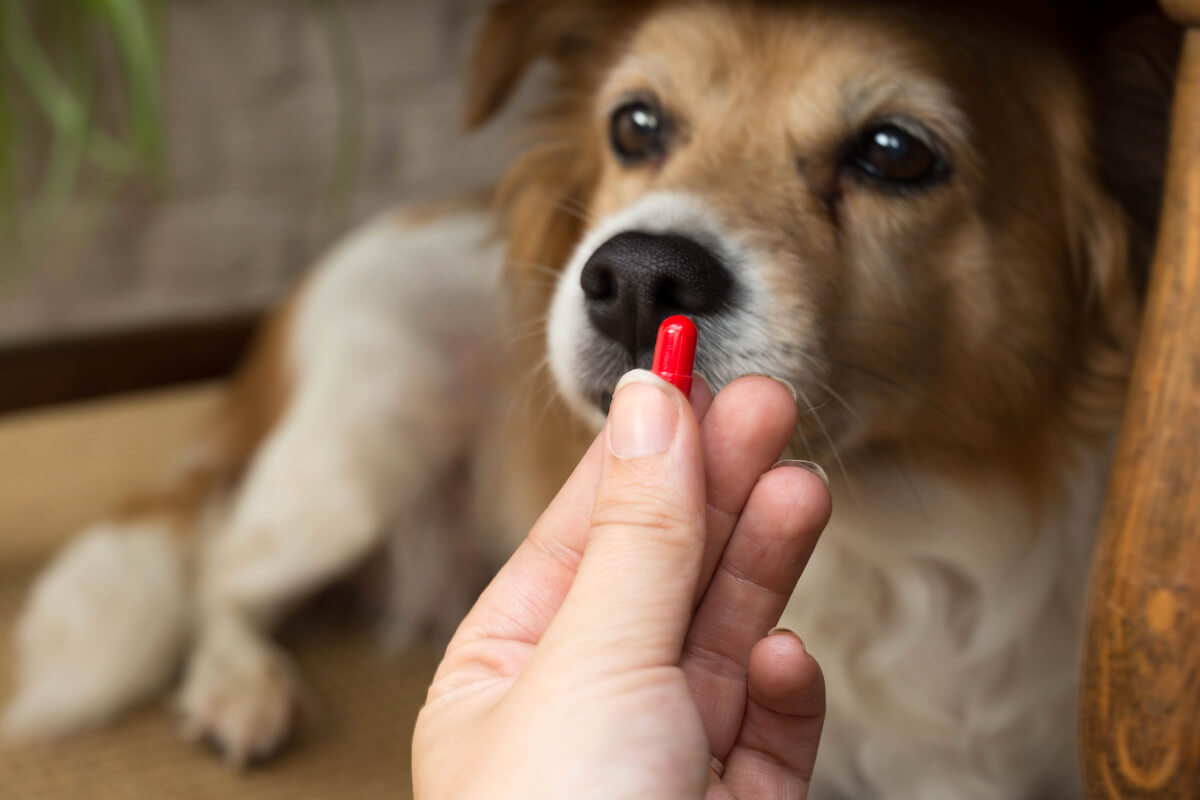Methylprednisolone for Dogs: Dosage and Contraindications


Written and verified by the vet Daniel Aguilar
The field of pharmacology is divided into different categories according to the action of the active substances of the medication. Some of them have the ability to exert more than one effect at a time. The use of methylprednisolone for dogs will carry out a number of positive reactions in their bodies, but, be careful, because it’s a drug that must be administered with caution.
In this article, we’ll talk about the main dosage of methylprednisolone in dogs, along with the contraindications to its use. Its administration, like all other drugs for veterinary purposes, should be indicated by a professional. Self-medicating your dog could be counterproductive in improving its general health and well-being.
What is methylprednisolone?
This drug is a synthetic steroid derived from prednisolone that’s characterized by having an immunosuppressive and anti-inflammatory action. In addition, its administration is considered to have a reduced tendency to retain sodium and water, due to its low mineralocorticoid activity.
When methylprednisolone is used in dogs, a number of very detailed physiological processes develop. We’ll tell you about them in the following lines.
Mechanism of action
This drug begins by inhibiting tissue mechanisms related to inflammation. Thus, it affects both inflammatory cells and inflammatory mediators. In turn, vascular permeability decreases and exudation is less.
Methylprednisolone is a drug that has the ability to be absorbed by all routes. It attaches itself to plasma globulins to travel through the bloodstream. The effects of methylprednisolone in dogs will depend on the route by which you administer the drug. However, parenteral administration is the one that reports the longest-lasting effects.
It should be noted that this drug has a hepatic metabolism that ends through elimination in the urine. However, the administered dosage of methylprednisolone in dogs may vary according to the established therapeutic plan.
Good results have been observed when applying this drug in canids with dermatological processes, such as dermatitis and pemphigus. Dogs with endocrine and rheumatic diseases, as well as intestinal, neurological, immune-mediated and musculoskeletal problems can also benefit from this drug.

Methylprednisolone dosage in dogs
As we have mentioned, the dosage will depend on the effect sought when starting a methylprednisolone-based treatment for dogs. Next up, we’ll present the different doses that the veterinarian could prescribe in the search for the resolution of different conditions.
Immunosuppressive dose
It begins with an oral administration of 2 to 4 milligrams for each kilogram of live weight of the animal, with a recommended interval of 24 hours. Once the dog is stable, the administration of methylprednisolone for dogs should be decreased until you reach the minimum effective dosage, which is around 1-2 milligrams per kilogram.
The veterinarian will recommend the ideal dosage interval based on the specific situation of the canid.
Anti-inflammatory and analgesic dosage
In oral presentation and respecting an interval of approximately 6 to 10 hours, the medicine will be administered as follows:
- 2 milligrams for every 2.3 to 6.8 kilos of weight.
- 2-4 milligrams for every 6.8 to 18.1 kilos of weight.
- 4-8 milligrams for every 18.2 to 36.6 kilos of weight.
The treatment can last between 2 and 7 days, depending on how the dog improves. Vets recommend that the daily dose be gradually decreased until the maintenance dosage is reached.
Contraindications of methylprednisolone for dogs
Among the benefits of the use of this drug, there is also an extensive list of contraindications. It is important to take into account each of the restrictions on the use of methylprednisolone for dogs, in order to prevent your pet’s health from worsening.
If your dog is suffering from any of the following pathologies, it’s best to seek another treatment:
- Systemic fungal infection
- Viral infections
- Resistant bacterial infections
- Corneal ulcers
- Chronic kidney disease
- Gastroduodenal disease
Before starting methylprednisolone-based treatment for dogs, the possible interactions that it may have when combined with other drugs should be considered. Non-steroidal anti-inflammatory drugs (NSAIDs), barbiturates, diuretics, indomethacin, salicylates, and antidiabetics are just some examples of drugs you can’t mix this steroid with.
If your pet is pregnant or breastfeeding, methylprednisolone for dogs isn’t the best option. An early administration can cause fetal malformations, as well as premature deliveries and abortions in the last third of gestation.
Side effects of methylprednisolone for dogs
Some side effects may occur, depending on how the dog assimilates the drug, as well as the duration and concentration administered. In some patients in whom very high doses were applied, there’s a greater chance of manifesting this type of reaction.
The main side effects when using methylprednisolone in dogs are growth retardation in young animals, osteoporosis, and signs of hyperadrenocorticism. Less common are polydipsia and polyuria, and in even more sporadic cases, Cushing syndrome could appear.
In pre-diabetic patients, methylprednisolone for dogs can lead to this disease developing fully. Glucocorticoids have an insulin-antagonistic effect, so it’s necessary to monitor these canids to keep them stable and prevent them from becoming diabetic dogs while they’re being treated.

Due to its immunosuppressive action, the symptoms caused by the infection of an opportunistic agent could go unnoticed. Professional medical support in methylprednisolone-based treatments for dogs, as well as any other medication that has been indicated for your pet, is essential.
The field of pharmacology is divided into different categories according to the action of the active substances of the medication. Some of them have the ability to exert more than one effect at a time. The use of methylprednisolone for dogs will carry out a number of positive reactions in their bodies, but, be careful, because it’s a drug that must be administered with caution.
In this article, we’ll talk about the main dosage of methylprednisolone in dogs, along with the contraindications to its use. Its administration, like all other drugs for veterinary purposes, should be indicated by a professional. Self-medicating your dog could be counterproductive in improving its general health and well-being.
What is methylprednisolone?
This drug is a synthetic steroid derived from prednisolone that’s characterized by having an immunosuppressive and anti-inflammatory action. In addition, its administration is considered to have a reduced tendency to retain sodium and water, due to its low mineralocorticoid activity.
When methylprednisolone is used in dogs, a number of very detailed physiological processes develop. We’ll tell you about them in the following lines.
Mechanism of action
This drug begins by inhibiting tissue mechanisms related to inflammation. Thus, it affects both inflammatory cells and inflammatory mediators. In turn, vascular permeability decreases and exudation is less.
Methylprednisolone is a drug that has the ability to be absorbed by all routes. It attaches itself to plasma globulins to travel through the bloodstream. The effects of methylprednisolone in dogs will depend on the route by which you administer the drug. However, parenteral administration is the one that reports the longest-lasting effects.
It should be noted that this drug has a hepatic metabolism that ends through elimination in the urine. However, the administered dosage of methylprednisolone in dogs may vary according to the established therapeutic plan.
Good results have been observed when applying this drug in canids with dermatological processes, such as dermatitis and pemphigus. Dogs with endocrine and rheumatic diseases, as well as intestinal, neurological, immune-mediated and musculoskeletal problems can also benefit from this drug.

Methylprednisolone dosage in dogs
As we have mentioned, the dosage will depend on the effect sought when starting a methylprednisolone-based treatment for dogs. Next up, we’ll present the different doses that the veterinarian could prescribe in the search for the resolution of different conditions.
Immunosuppressive dose
It begins with an oral administration of 2 to 4 milligrams for each kilogram of live weight of the animal, with a recommended interval of 24 hours. Once the dog is stable, the administration of methylprednisolone for dogs should be decreased until you reach the minimum effective dosage, which is around 1-2 milligrams per kilogram.
The veterinarian will recommend the ideal dosage interval based on the specific situation of the canid.
Anti-inflammatory and analgesic dosage
In oral presentation and respecting an interval of approximately 6 to 10 hours, the medicine will be administered as follows:
- 2 milligrams for every 2.3 to 6.8 kilos of weight.
- 2-4 milligrams for every 6.8 to 18.1 kilos of weight.
- 4-8 milligrams for every 18.2 to 36.6 kilos of weight.
The treatment can last between 2 and 7 days, depending on how the dog improves. Vets recommend that the daily dose be gradually decreased until the maintenance dosage is reached.
Contraindications of methylprednisolone for dogs
Among the benefits of the use of this drug, there is also an extensive list of contraindications. It is important to take into account each of the restrictions on the use of methylprednisolone for dogs, in order to prevent your pet’s health from worsening.
If your dog is suffering from any of the following pathologies, it’s best to seek another treatment:
- Systemic fungal infection
- Viral infections
- Resistant bacterial infections
- Corneal ulcers
- Chronic kidney disease
- Gastroduodenal disease
Before starting methylprednisolone-based treatment for dogs, the possible interactions that it may have when combined with other drugs should be considered. Non-steroidal anti-inflammatory drugs (NSAIDs), barbiturates, diuretics, indomethacin, salicylates, and antidiabetics are just some examples of drugs you can’t mix this steroid with.
If your pet is pregnant or breastfeeding, methylprednisolone for dogs isn’t the best option. An early administration can cause fetal malformations, as well as premature deliveries and abortions in the last third of gestation.
Side effects of methylprednisolone for dogs
Some side effects may occur, depending on how the dog assimilates the drug, as well as the duration and concentration administered. In some patients in whom very high doses were applied, there’s a greater chance of manifesting this type of reaction.
The main side effects when using methylprednisolone in dogs are growth retardation in young animals, osteoporosis, and signs of hyperadrenocorticism. Less common are polydipsia and polyuria, and in even more sporadic cases, Cushing syndrome could appear.
In pre-diabetic patients, methylprednisolone for dogs can lead to this disease developing fully. Glucocorticoids have an insulin-antagonistic effect, so it’s necessary to monitor these canids to keep them stable and prevent them from becoming diabetic dogs while they’re being treated.

Due to its immunosuppressive action, the symptoms caused by the infection of an opportunistic agent could go unnoticed. Professional medical support in methylprednisolone-based treatments for dogs, as well as any other medication that has been indicated for your pet, is essential.
All cited sources were thoroughly reviewed by our team to ensure their quality, reliability, currency, and validity. The bibliography of this article was considered reliable and of academic or scientific accuracy.
Romero A. Dosis de metilprednisolona en perros: ¿siempre la misma? Barcelona, España. Consultado el 8 de julio de 2021. Disponible en: https://www.affinity-petcare.com/vetsandclinics/es/dosis-de-metilprednisolona-en-perros-siempre-la-misma
Depo-moderin 40 mg/ml suspensión inyectable. Madrid, España. Consultado el 8 de julio de 2021. Disponible en: https://cimavet.aemps.es/cimavet/pdfs/es/p/715+ESP/P_715+ESP.pdf
Vaquero P. El uso de corticosteroides en el tratamiento de enfermedades neurológicas en pequeños animales. España. Consultado el 8 de julio de 2021. Disponible en: https://www.imveterinaria.es/uploads/corticosteroides_tratamiento_717_21135309
Resumen característico del producto DEPO-MODERIN. Madrid, España. Noviembre 2014. Consultado el 8 de julio de 2021. Disponible en: https://dhb3yazwboecu.cloudfront.net/1032/fichas/32/depomoderin.pdf
Depo-medrol solución inyectable. México. Consultado el 8 de julio de 2021. Disponible en: https://www.zoetis.mx/products/gatos/depo-medrol.aspx
This text is provided for informational purposes only and does not replace consultation with a professional. If in doubt, consult your specialist.








